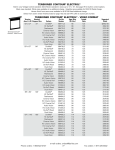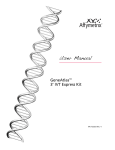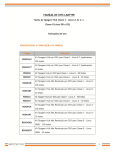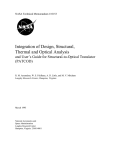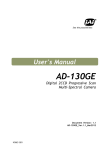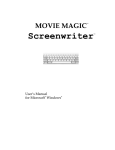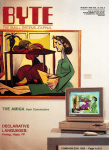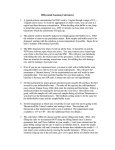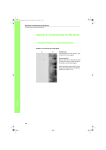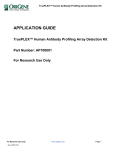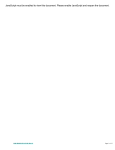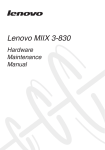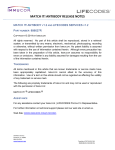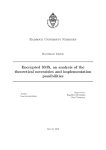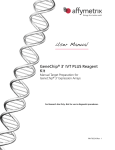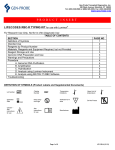Download - 1 - Chapter: DNA Based Testing Section: Application - ASHI-U
Transcript
Chapter: DNA Based Testing Section: Application Modules Module : Reverse SSO by Luminex Author(s): Sharon Skorupski, CHT, Henry Ford Hospital, Detroit, MI Tamara German, Henry Ford Hospital, Detroit, MI Susan Saidman, [email protected] Toni Lyrenmann, [email protected] Date Prepared: 08/20/2006 OBJECTIVES - 1 - ! Understand the basic technique used to perform rSSO testing using the One Lambda and the GenProbe Lifecodes software. ! Understand the similarities and differences between the One Lambda and Gen-Probe Lifecodes SSO Typing kit. ! Understand how to interpret test results and provide the final answer: the patient’s HLA typing result. ! Understand and identify the ASHI standards that pertain to the compliance of the assay, all pertinent equipment, and the quality control measures required for this test system. - 2 - INTRODUCTION The sequence specific oligonucleotide (SSO) assay for HLA typing utilizes a single PCR reaction per each HLA locus. This is followed by hybridization to a series of labeled sequence specific probes that are used to determine which specific allele or group of alleles is present. In the forward SSO technique, amplified DNA is attached to a membrane and each membrane is hybridized with a different probe. Since multiple probes are required for even low resolution typing, numerous membranes are needed. In the standard dot blot format, multiple amplified DNAs are applied to each large membrane. All the DNAs are then simultaneously hybridized with each probe. Therefore, this dot blot format is much better suited to high volume batch testing. The rSSO (aka Reverse Sequence Specific Oligonucleotide probe) technique is a variation of the SSO methodology. In this case, the probes are attached to a bead or membrane, and labeled amplified DNA is added for hybridization. rSSO is much more suited to lower volume individual patient testing. The two most common methods of rSSO testing involve either a color change on a nitrocellulose membrane or a fluorescent tag that is read by a flow cytometer. Both methods allow for small batches of patient samples. The nitrocellulose membrane method involves a PCR reaction with biotinylated primers, followed by hybridization and detection. The nitrocellulose strip has multiple probes attached to it. The biotinylated PCR product is mixed in a well with the strip. If the amplified product will recognize specific binding sites on the probes and will attach to the strip at those specific probes. After addition of various reagents and incubations, the final product is detected by a color change at the location of the probes where the DNA is bound. The probes are identified by comparing them to a control strip and then analyzed using a computer program. The second rSSO method (with fluorescent probes) is utilized by both One Lambda and Gen-Probe Lifecodes. In the One Lambda method, extracted DNA is amplified using primers that are specific for each of the individual HLA loci. The PCR product is biotinylated, which allows it to be detected using a fluorescent tag. The amplified product is denatured using a pH change to make a single strand of DNA. This is then hybridized to a series of probes specific for nucleotide sequences that are used to define the HLA alleles. The probes are bound to a series of fluorescently coded beads (Luminex technology). Stringent washes are performed to wash off any PCR product that does not exactly match the sequence detected by the probe. The bound PCR product is labeled with streptavidin conjugated with a PE fluorescent tag (“SAPE”) and detected using the LABScan TM system. Using a flow cytometry analyzer, the intensity of PE fluorescence on each bead will be measured. Software is used to assign positive or - 3 - negative reactions based on the strength of the fluorescence signal and identify HLA alleles that are present. Lifecodes method for DNA amplification also uses labeled locus specific primers to produce biotinylated amplified DNA, followed by hybridization to a mix of sequence specific probes bound to fluorescent beads. However, the Lifecodes method differs from the One Lambda method in the following ways. Lifecodes employs equimolar amounts of both forward and reverse primer to generate a double-stranded DNA product. There is no separate denaturation step. Hybridization takes place in a thermocycler for 45 minutes, then SA-PE is added and the sample is read in the LABScan TM system. There are no wash steps with LifeCodes method. HLA assignment is done using LifeCodes software. The rSSO methodology is commonly used due to its relatively quick turn around time, good reproducibility, and ability to give a clear cut answer. The extensive number of antigenic probes represented on the assay beads results in fewer ambiguities, therefore requiring almost no need for further testing to clarify the final answer. Currently, there are assay bead kits available which can result in allele level typings. This module will describe in detail the fluorescent label methods for both One Lambda and Gen-Probe Lifecodes SSO kits. - 4 - METHODOLOGIES Commercial kits containing all required reagents are available. Such kits have undergone extensive quality control measures to determine the appropriate working conditions of the assay. The manufacturers provide training for using their product and continuous technical support. Validation of the assay is required by the laboratory prior to clinical use, regardless of the quality control provided by the manufacturer. There are currently two commercial suppliers of this methodology: One Lambda and GenProbe. Due to the easy availability of commercial kits, the significant amount of quality control required and the constant discovery of new HLA alleles, performing this test as a “home brew” method is not an easy task and not recommended. A comparison of One Lambda vs Lifecodes kits: One Lambda Lifecodes Amount of DNA Req’d for PCR PCR Time 20 ng/ul 10-200 ng/ul ~2 hours ~1.5 hours SAPE: R-phycoerythrin conjugated streptavidin NOTE: Lifecodes is a division of Gen-Probe - 5 - Processing Time from Hyb to SAPE ~1.5 hours ~1 hour PROTOCOLS Procedure I: Analysis of HLA Class I and Class II Loci by Reverse PCR-SSOP Using the One Lambda SSO System Purpose: To describe the process of identifying the HLA alleles carried by a patient or donor. Since the proteins coded by the HLA genes are expressed on the cell surface and are involved in transplant rejection and graft-versus-host disease, the information regarding HLA types is used to help match recipient and donor for solid organ and bone marrow or stem cell transplantation. It is also used to identify the presence or absence of specific HLA antigens or alleles that have been found to be associated with an increased risk for certain diseases or for vaccine development or other immunological studies. Extracted DNA is amplified using biotinylated group specific primers. The PCR product is biotinylated, which allows it to be detected using R-Phycoerythrin conjugated (PE) streptavidin(SAPE). The PCR product is denatured and rehybridized to probe conjugated to fluorescent-coded microspheres. The TM beads carrying the PCR products are detected with SAPE using the LABScan 100. A flow analyzer, the TM LABScan 100, identifies the fluorescent intensity of PE (phycoerythin) on each microsphere. HLA assignment is identified using One Lambda software. Specimen: Genomic DNA extracted from ACD (solution A or B), EDTA, or ficoll separated blood; buccal mucosal scrapings, paraffin embedded tissue, cultured cells ortissue biopsy and stored at 2-8 °C (in the pre-PCR room) or –70 ºC. DNA extracted from heparin-preserved blood cannot be used in this assay. Optimal DNA concentration: 20 ng/ul Controls: Positive Control- previously run DNA, UCLA DNA exchange proficiency samples or CAP samples Negative Control– No DNA (purified DNA/RNA free water) Materials: RSSO1A - “A” locus typing kit. RSSO1B - “B” locus typing kit RSSO1C - “C” locus typing kit RSSO2B1 - “DRB1“locus typing kit RSSO2QB1 -“DQB1” locus typing kit ***The above typing kits are dissembled and stored at the following conditions: Unopened bead vials: Store at -70ºC until expiration date. (Opened bead vials: Store at 2-8ºC until expiration date). Denaturation buffer: Store at room temperature (20-24ºC) until expiration date. Neutralization buffer: Store at room temperature (20-24ºC) until expiration date. Hybridization buffer: Store at room temperature (20-24ºC) until expiration date. - 6 - Wash buffer: Store at room temperature (20-24ºC) until expiration date. Water, ultra pure, DNAse and RNAse free (Sigma #W4502). Store at room temp (20-24ºC) until exp. date. R-Phycoerythrin-conjugated strepavidin + buffer (SAPE) (Cat# LT-SAPE). PROTECT FROM LIGHT! Store at 2-8ºC until expiration date. Deionized water. Store opened bottles for 2 weeks at room temperature (20-24ºC). 70% Ethanol. Store at room temperature (20-24ºC) until expiration date. 20% Bleach. Store at room temperature (20-24ºC) until expiration date. Sheath Fluid (Luminex Corporation). Store at room temperature (20-24ºC) until expiration date. Luminex Calibration and Control Beads. PROTECT FROM LIGHT! Store at 2-8ºC until expiration date. Equipment TM LABScan Flow Analyzer Centrifuge (13,000 x g) Vortex mixer with adjustable speed Thermocycler 15-50 ml disposable tubes thin walled PCR tubes microamp base and tray holder Tray seal (one Lambda #SSPSEA300) PCR pad 1.5 ml microfuge tubes Bead resistant tips Pipets MLA adjustable pipets 96 well 0.2ml tube plate Multi-channel pipet Whatman V bottom plates 96 well cold tray or wet ice IMPORTANT~Bead Handling and Storage TM LABType beads must be evenly distributed before dispensing. Always mix beads vigorously by pipetting up and down several times or by vortexing for 30 seconds. 0 Protect beads from light during usage and storage. Store beads at –20 C in a tightly covered container until ready to use. NOTE: Once beads are thawed, store at 2-8 ºC and use within 3 months. Do not refreeze. Procedure: Amplification: Set Up (done in pre-PCR room) 1. Set up a tray of strip tube for each locus under the hood. Layout of tray should include one positive control and one negative control for each locus tested. 2. Fill out a Luminex tray layout sheet (see attachment page 26) in the same order the samples will be placed in the PCR tray. Label tubes to identify the locus for each group of samples in the appropriate space on the worksheet. (Negative control should be set up last) - 7 - 3. Thaw DNA, amplification primers, and D-Mix. Keep all reagents cool until ready to use. 4. Vortex D-Mix and primers for 15 seconds. Spin briefly. 5. Using the table below as a guide, mix indicated volume of D-Mix and primers. (When doing calculations for your mixture, allow for 2 extra reactions to account for reagent loss during pipetting.) Vortex for 15 seconds. # Rxns (samples/loci) 1 10 20 50 Amplification Mixture D-Mix (ul) Amplification Primer (ul) 13.8 4 138 40 276 80 690 200 Taq Polymerase (ul) 0.2 2.0 4.0 10 6. Add Taq polymerase immediately before use to your D-Mix/primer tubes. 7. Pipette 2 ul of DNA into the bottom of your PCR tubes. 8. Add 18 ul of D-Mix/primer/taq solution into each well containing DNA. 9. Cap tubes tightly. Close lid and tighten. 10. NOTE: Spin tray in centrifuge for 15 seconds to force all liquid to the bottom of the tubes before placing in the thermocycler. 11. Run “LABType TM “ Step Step 1: Hold Step 2:Cycle Step 3:Cyle Step 4:Hold Step 5:Hold SSO PCR program as shown below: SSO PCR Program Temperature and Incubation Time 0 96 C 03:00 0 96 C 00:20 0 60 C 00:20 0 72 C 00:20 0 96 C 00:10 0 60 C 00:15 0 72 C 00:20 0 72 C 10: 00 0 4 C forever # of Cycles 1 5 30 1 1 12. Upon completion of thermocycling, amplified DNA is now ready to be tested. 13. Amplified DNA can be stored at 2-8ºC, -20ºC, or -70ºC if not proceeding immediately to next step. 14. It is recommended, but not required, that amplification is confirmed by running 2-5 ul of the PCR product on an agarose gel. - 8 - Detection: Denaturation/Neutralization NOTE: Make sure a thermocycler is available for use before starting this phase of assay. 1. Remove tray containing amplicons from refrigerator or freezer. 2. Let the tray sit at room temperature (20-24ºC) for 15 minutes before using. 3. Spin tray for approximately 15 seconds before removing caps. 4. Place a clean 96 well AB Gene tray in a tray holder. 5. Transfer 5 ul of each amplified DNA sample into the corresponding well of the 96 well plate. Make sure locations and sample numbers correspond to your original PCR tray (If not, please make sure you note this on your Luminex layout sheet). Original tray may be resealed and stored at -20ºC indefinitely. 6. Using a multichannel pipet, add 2.5 ul of Denaturation Buffer to the bottom of each well containing amplified DNA. Cover with tray seal, vortex plate, and incubate at room temperature for 10 minutes (mixture will change to a shade of pink when properly mixed). NOTE: Immediately remove the pink 96 well cold tray from the –20ºC freezer; it must stay at room temperature for approximately 15 minutes before placing sample tray in it. 7. Using a multichannel pipet, add 5 ul of Neutralization buffer. Vortex. Note the color change from pink to pale yellow. If color has not changed to pale yellow, add 1 ul of Neutralization buffer. Vortex. 8. Place PCR tray containing neutralized product on the pink 96 well cold tray. Another option: place 96 well sample tray on ice. Detection continued: Hybridization 9. Turn the thermocycler on to the 60ºC hold program before proceeding. 10. Combine appropriate volumes of Beads and Hybridization Buffer to prepare Bead/Hybridization mixtures (see SSOP worksheet or the table below). Bead Mixture and Hybridization Buffer Volumes # of Tests (samples/loci)) 1 10 20 25 50 Hybridization Buffer (ul) 34 340 680 850 1700 Beads (ul) 4 40 80 100 200 Note 1: Make sure the beads are well mixed prior to use. Note 2: Make sure to add 2 extra rxns for each calculation to allow for sample loss during pipetting. 11. Add 38 ul of Bead/Hybridization mixture to appropriate wells. - 9 - 12. Cover tray with tray seal and vortex thoroughly at low speed. 13. Remove from tray holder and place PCR tray into the pre-warmed thermocycler (60ºC hold program). 14. Place PCR pad on top of the tray. Close and tighten lid. Incubate for 15 minutes. 15. After incubation, place tray in a tray holder, remove seal and quickly add 100 ul of Wash Buffer to each well. Cover tray with tray seal. Note: Leave thermocycler on until the labeling step is complete. 16. Centrifuge tray for 5 minutes at 1300 x g. 17. After centrifugation, remove the PCR tray from its base and quickly hold the tray upside down and gently flick off the wash buffer while holding the tray in a horizontal position. 18. Repeat wash steps 2 more times for a total of 3 washes. NOTE: After the final wash, be sure that less than 10ul of buffer is left in the wells. If more than 10ul remains, repeat wash/centrifuge/flick steps. 19. Prepare 1X SAPE solution during the third centrifugation. See SSOP worksheet or the table below as a guide: SAPE and SAPE Buffer Volumes # of Test SAPE stock soln (ul) (samples) 1 0.5 10 5.0 20 10.0 25 12.5 50 25.0 SAPE Buffer (ul) 49.5 495.0 990.0 1237.5 2475.0 Note: Make sure to add 10 extra reactions to allow for sample loss during pipetting. Detection continued: Labeling 20. After the last centrifugation and flick, place tray in tray holder. Add 50 ul of 1X SAPE solution to each well. 21. Place tray seal on tray and vortex thoroughly at low speed. Place tray in the pre-heated thermocycler (60ºC). Place PCR pad on top of tray. Close and tighten lid. Incubate for 5 minutes. 22. After incubation, remove tray seal and quickly add 100 ul of Wash Buffer to each well. 23. Cover with tray seal and centrifuge tray for 5 minutes at 1300 x g. 24. Remove PCR tray from centrifuge and quickly flick off wash buffer. NOTE: After the final wash, be sure that less than 10ul of buffer is left in the wells. If more than 10ul remains, repeat wash/centrifuge/flick steps. 25. Add 70 ul of Wash Buffer to each well. Gently mix by pipetting up and down several times with multichannel pipettor. - 10 - 26. Transfer samples to a white Whatman V bottom reading plate. Cover tray with tray seal. Keep tray in the dark and at 2-8ºC until ready to read. NOTE: Make sure your reading tray is properly oriented before you transfer the samples. 27. For best results, read samples immediately. Be sure to thoroughly mix the samples immediately before reading. NOTE: If not acquiring samples immediately, cover tray with tray seal and keep at 2-8º C until ready to read. Sample Reading (or Detection): Luminex reads samples from 1A thru 1H then 2A thru 2H, etc…. 1 2 3 4 5 6 7 8 9 10 11 12 A ? ? ? ? ? ? ? ? ? ? ? ? B ? ? ? ? ? ? ? ? ? ? ? ? C ? ? ? ? ? ? ? ? ? ? ? ? D ? ? ? ? ? ? ? ? ? ? ? ? E ? ? ? ? ? ? ? ? ? ? ? ? F ? ? ? ? ? ? ? ? ? ? ? ? G ? ? ? ? ? ? ? ? ? ? ? ? H ? ? ? ? ? ? ? ? ? ? ? ? For use with Luminex IS v2.3 Data acquisition: Luminex Machine Daily Start Up and Calibration TM *The LABScan is an advanced flow analyzer that requires daily maintenance and calibration. TM TM Refer to the LABScan user manual (Luminex User’s Guide) for all necessary maintenance operation. Daily maintenance includes routine start-up and shutdown procedures. The instrument must be calibrated as part of the start-up routine. In addition, calibrate the instrument whenever the d Cal Temp temperature shown on the system monitor is more than (+ or -) 2ºC. Note: Allow the Calibration and Control bottles to come to room temperature prior to use. 1. Turn on the Luminex. Turn on the computer. Verify that the sheath delivery system is on. 2. Double click on the Luminex icon on the desktop. 3. When the Luminex software loads, laser Warm Up usually starts automatically. If not, click Warm Up. This process takes about 30 minutes (1800 seconds). 4. During or after Warm Up is complete, click on Prime. Click on OK. (Instrument will prime for 30 seconds). 5. Repeat this step. - 11 - 6. Click on Alcohol Flush. Click on eject. Fill reservoir with 70% alcohol. Click on OK. This takes about 5 minutes (removes air bubbles in the lines). 7. Click on Wash. Click on eject. Fill the reservoir with Sheath Fluid. Click OK. Cick on Wash and OK to repeat. 8. Perform instrument calibration using Luminex Calibrator and Control reagents (reagents must be at room temperature prior to use). Use a 96 well Whatman V bottom reading plate (white). 9. Calibration reagents are CAL1 and CAL2. Control reagents are CON1 and CON2. Vortex vigorously prior to use. Add 3-4 drops of each of the reagents to the calibration plate. (Make sure the sample location you are dispensing the reagents into matches the sample location on the drop down menu.) 10. Click on New CAL Target from the maintenance menu to enter or confirm the lot number of the calibration reagents. If necessary, update new information found in the kit. When finished, click on CAL1 on the menu to proceed with the first calibration. 11. Perform a Wash step after calibration. 12. Repeat step 10 for CAL2, CON1 and CON2. (Perform a Wash step after each calibration). 13. Verify that all calibration has passed. Click on Diagnostics menu. Green indicates pass and red indicates failure. Contact supervisor or director if calibration fails; also fill out corrective action form. 14. Print the calibration and control reports. Go to File and click on Print Report. Click on “Calibration Trend Report”. Select Cal 1. Print. Do the same for Cal 2 and print. i. Click on System Control Trend. Select Con1 and print. Do the same for Con2 and print Data Acquisition: Collection of sample data In order to obtain valid data, two parameters – count and fluorescence intensity – must be monitored for each data acquisition. Count represents the total number of beads that has been analyzed, and should be above 50. A significant reduction in the count suggests bead loss during sample acquisition or assay and can void test results. Fluorescence intensity (FI) represents a PE signal detected within the counted beads. FI varies based on the reaction outcome. The FI for the positive control probe is expected to be 800 to 4000, depending on the bead pool and lot. Significant reduction in the FI for the positive control probe suggests inadequate sample quantity and/or quality, poor assay efficiency, or instrument failure and can void test results. 1. Create your patient load list. This will vary as each laboratory will have their own software, unique naming of their patient list etc. See Appendix for an example. 2. Open Luminex sotftware. 3. From the Home Menu, select New Multi-Batch icon. 4. Enter your file name in the Multi-batch name dialog box. i. Ex. 052505TG (date of PCR amplification + initials of the tech running the Luminex). 5. Click on New Batch. - 12 - 6. Highlight the template you wish to run (this is specific for the catalog number of the reagent/kit). Click on Select. 7. Enter the necessary information under the Batch Info dialog box. 8. Under name (*), type in the date of the PCR amplification, plus the Loci, plus the Lot #. Ex. 052505A L#5 9. Enter your tech initials and any description you wish. 10. Click on Load Patient List. 11. Select the load list you want. 12. Verify that the samples are loaded in the correct location as shown on your Luminex Plate Layout run sheet. If not, drag the highlighted square box around #1A to the desired location. 13. Click on Finish. 14. Continue doing steps 4 through 12 until all your samples are loaded. This needs to be repeated for each locus. 15. Once done, click on Finish again to save the Multi-Batch file. 16. Vortex the samples prior to loading on the Luminex. Click on Eject/retract to open the plate holder, load your plate and click on retract. When ready, click on Start plate. You will see the pressure gauge going up (pressure needle must be between the two green arrows). 17. Click on Acquisition Details or Diagnostics to visually see the data acquisition. Allow 2 to 3 samples to acquire before leaving the instrument. Check to make sure the majority of the beads fall within the circles (probes). Once satisfied, you can let the instrument run until acquisition is complete. NOTE: Acquisition time per sample will vary between 10 to 90 seconds, depending on the bead count. Data Acquisition: Instrument Shut Down 1. Click on Wash 2 times, placing Deionized water in the reservoir (takes about 30 seconds). 2. Click on Sanitize once, placing 20% bleach in the reservoir. 3. Click on Wash 3 times, placing Deionized water in the reservoir (wash rinses off the probe). 4. Click on Soak, leaving Deionized water in the reservoir(soak empties sheath fluid inside the probe, and replaces it with deionized water). 5. Check waste reservoir and empty as necessary. NOTE: Refer to the Luminex User’s Guide for recommended weekly and monthly maintenance schedule. Data Analysis: A. Launch HLA Fusion software. - 13 - B. Click on LABType icon (looks like double helix) in top tool bar. C. Click on folder icon on top left corner of screen. D. Browse to Luminex Raw Data>Output. E. Find sessions to be analyzed. Highlight all low definition sessions to be analyzed. Click Open. F. Sessions will populate on left side of screen under CSV file name. It may be necessary to click Include Imported CSVs in upper left corner to make session populate. G. Highlight first session. Check that catalog is correct. If not, select correct catalog from pulldown list. Click Import. H. After session imports, it will populate in Navigator on right side of screen. I. In Navigator, click once on session to be analyzed. Wait for Retrieving Session Information window to close. Analyzing Sample . . . at bottom of screen indicates progress of session analysis. Wait until this is complete. J. Click on Exon 2 (and Exon 3, if applicable). Lowest positive control values will populate at the top. Note low positive controls (if < 500 FI, sample needs to be repeated) or amplification failures (samples will need to be repeated). K. Click on Min Bead Count. Note samples that have low bead count. Every laboratory will need to set their criteria if the sample requires repeating. L. If pre-analysis is to be done, click the “exclude” box next to all failed amps, including negative control. M. Click on Position; samples should now populate in order. N. Check list of samples against plate map. Initial at bottom of locus to indicate this double check has been done. Reviewing technologist will repeat this check and initial as well. O. Double click on first sample in session. P. Check in Utilities to verify serological equivalent function is activated. 1. Click on Utilities on top tool bar. 2. Select Molecular Product Configuration>Molecular Analysis Configuration. 3. Computer Assigned Serology at bottom of screen should be checked. If it isn’t, click on it and click “OK” to notice that pops up. SAVE. Q. If analysis looks acceptable, click on Assign (or Alt-A) to move to next sample. R. If analysis indicates a false reaction for a specific bead, click on the bead pull-down list and select the bead in question. If it is plausible that the cutoff should be changed, make the adjustment. Note change made in comments (under lower left quadrant). S. If adjustment results in clearly assigned alleles, click on Assigned Sero at bottom of screen to get the serological equivalents to populate. T. Continue to click Assign or (or Alt-A) until all samples for that locus have been analyzed. U. Repeat analysis steps I-U for remaining loci. Sample Reports A. In FUSION, click on Reports on top tool bar. - 14 - B. In Session window, type in Session Name (no loci). Make sure asterisk remains in place (e.g. SAMPLERUN#*). Click FIND. C. All loci tested for that sample set will populate on top right of screen. D. Check small square under Include for all loci. E. On bottom of screen, click on Sample and Locus. This will sort samples in correct order. F. Click on Reporter at top of screen. G. Click on Generic Typing and Molecular Custom. H. Check box next to 1 Sample Per Report. I. Click on View Report. J. Reports will populate on right side of screen. (This will take awhile). K. Click on Printer icon. Click OK. Assay Validation Benchmark: 1. Positive Control bead Fluorescence Intensity (FI) must be greater than or equal to 500. 2. Negative Control bead Fluorescence Intensity (FI) must be less than or equal to 80. NOTE: If any or these benchmarks are out of range, please consult the supervisor or lab director for further instructions. Data Calculations: 1. The Fluorescence Intensity generated by the Luminex Data Collector Software, or equivalent, contains the FI for each bead (or probe bound to the bead) per sample. The percent positive value is calculated as: a. Percent Positive Value = 100 x FI (Probe n)- FI (Probe Negative Control)/FI (Probe Positive Control)-FI (Probe Negative Control) i. A reaction with the percent positive value higher than the pre-set cut-off value for that probe will be considered positive. ii. A reaction with the percent positive value lower than the cut-off value will be considered negative. - 15 - Troubleshooting: NOTE: In the event that the test system is inoperable due to assay problems, notify supervisor or director immediately. One Lambda customer support is available for troubleshooting. The following are examples of some problems that may be encountered. 1. Positive DNA control results give inappropriate results a. If the wrong answer is obtained for the positive control, it must be investigated before the run is accepted. 2. Reactivity seen in the negative control well a. The entire run will need to be repeated to ensure there was not any DNA contamination 3. No Amplification of patient sample a. All patient samples that do not amplify are re-extracted and repeated. If the same results are obtained after the second amplification, consult with the supervisor or director. Verify the DNA concentration and purity using the spectrophotometer. 4. Ambiguous Alleles a. Ambiguous allele combinations should be resolved using PCR-SSP. If these groups cannot be identified by PCR-SSP, then PCR SBT (sequence based typing) must be performed. Family studies may be helpful in some cases. b. If an unusual or infrequently seen combination of alleles is presented as a possible answer, it is acceptable to report out the common typing with a footnote explaining that the lab is unable to rule out the rare allele combination and that further testing is available upon request. 5. Homozygosity of patient alleles a. Samples that exhibit homozygosity may be reported if the integrity of the probe signals are valid (no weak probe signals). All homozygous test results must include a statement indicating that a second unidentified allele may be present and family studies are recommended. b. Note: If two alleles belonging to the SAME GROUP are identified, the sample is NOT considered to be homozygous. For example, DRB1*03XX where 03XX may be DRB1*0301,0302, or 0301,0305. This sample is homozygous at the group specific level but clearly heterozygous at the allele level. 6. Positive control Fluorescent intensity (FI) low a. If the FI of the positive control bead is less than 800, results must be flagged for supervisor and/or director review prior to release of results. This could be due to incomplete binding of fluorescent tag during hybridization and detection. If the majority of the samples appear to have signal above 800, it is most likely a problem with the sample itself and not the entire run. If other loci for the sample worked fine, it is not likely to be a problem with the extracted DNA. Repeat the test for that sample only. b. If the entire run has low intensity, it is most likely a problem with the detection step. Repeat the detection step for all samples. SAPE will lose its intensity the longer it is sitting around in its prepared formula. Try to use the SAPE up in a timely manner. 7. Negative control Fluorescent Intensity (FI) high a. If the FI of the negative control bead is greater than or equal to 80, result must be flagged for supervisor and/or director review prior to release of results. - 16 - b. This could be due to inadequate washing. Splashing or contamination could cause a false positive in the negative well. The contamination may have occurred during the preparation of the PCR product or during hybridization or detection step. c. If the FI is above 80 on the negative control sample for the run, repeat the run. If the FI is above 80 for an individual sample, determine if the test needs to be repeated on a case by case basis. 8. Bead Counts a. If bead count is less than or equal to 50, result must be flagged for supervisor and/or director review prior to release of results. b. Low bead count is usually the result of “flicking” too hard while washing the plate. c. If result is consistent with common haplotype inheritance patterns and/or family typings, result may be released. d. If not consistent or unsure of result, repeat detection step only. If count still low and result consistent with first typing, report result. If result is not consistent, repeat test from primary amplification. 9. Unexpected Family Haplotypes a. If unexpected family haplotype results are obtained, notify supervisor or director immediately, and: i. Review all result data for analysis or transcription errors. ii. Contact transplant coordinator to confirm family relationships. iii. Repeat DNA extraction and PCR from original vial or obtain a new sample. iv. Consult director for further action if problem not resolved. - 17 - Limitations of Assay The LABType SSO system combines an HLA locus specific DNA amplification process and DNA-DNA hybridization process. The procedure, as well as the equipment calibration described in this procedure, must be strictly followed. DNA amplification is a dynamic process that requires highly controlled conditions to obtain PCR products that are specific to a target segment of HLA gene(s). The procedure, including proper DNA concentration, proper PCR conditions, proper temperature and storage of reagents must be followed. Reagents for the pre-PCR process must be physically separated from reagents used for the detection and “post-PCR” product procedures. Frequent wipe tests to check for contamination are required. The results of this test are dependent upon proper storage conditions of all reagents. All reagents are temperature sensitive. SAPE and the bead mixture is also light sensitive. Multiple freeze/thaw cycles is not recommended for any of the reagents except for the D mix. When compared to SSP, SSO has more ambiguities because the probes used in SSO can interrogate sample DNA at only one region per test, whereas SSP can interrogate sample DNA at two regions per test. However, LABType kits include “specialty” probes that target at least two non-contiguous regions at the same time, which has reduced the ambiguities previously found in SSO methods. A list of resolution limitations is provided with each kit. All equipment and instruments must be calibrated according to the manufacturers’ instructions. Interferences: Isolated DNA samples should not be resuspended in solutions containing chelating agents, such as EDTA, which are above 0.5mM in concentration. Precautions: 1. As with any exposure to human blood products, wear proper personal pretection at all times. 2. Ethidium bromide, which is used in agarose gel electrophoresis, is a known carcinogen. Handle with appropriate caution. It can be absorbed through the skin. Avoid splashing on skin or in eyes or on clothing. Keep tightly sealed. Wash hands thoroughly after handling. Flush spill area with large amounts of water. 3. Denaturization Buffer and Neutralization buffer are corrosive and may cause burns. In case of contact, immediately flush eyes or skin with a copious amount of water for at least 15 minutes while also removing contaminated clothing. (see MSDS) 4. Proper PPE must be worn according to the procedure being performed. A labcoat and disposable gloves must be worn when performing this procedure. 5. Pre-PCR room Precautions: All pre-amplification steps must be performed in a Pre-PCR room. All persons performing this procedure must wear clean gloves, disposable lab coats and shoe covers. The work area must be cleaned with 10% bleach and 70% ethanol before and after use. Place a protective, plastic-backed lab mat or sterile field on the bench before assembling the reagents and supplies needed for the PCR. Keep reagents and supplies confined to the lab mat. Discard the mat after each PCR set-up. 6. Aerosol resistant tips must be used throughout the setup procedure. - 18 - Procedure II: Analysis of HLA Class I and Class II Loci by Reverse PCR-SSOP Using the Lifecodes SSO Kit Purpose: To describe the process of identifying the HLA type of a patient or donor. This information is used to help match recipient and donor for solid organ and bone marrow or stem cell transplantation. It is also used to identify the presence or absence of specific HLA antigens or alleles that have been found to be associated with an increased risk for certain diseases During amplification, once the limiting primer is exhausted, the remaining primer uses the doublestranded product as a template for generation of single-stranded DNA. This method generates both double stranded and single stranded products that upon denaturation, will both participate in the hybridization reaction. The PCR product is biotinylated, which allows it to be detected using RTM Phycoerythrin conjugated (PE) streptavidin (SAPE). A flow analyzer, the LABScan 100, identifies the fluorescent intensity of PE (phycoerythin) on each microsphere. HLA assignment is done using LifeCodes software. Specimen: DNA extracted from whole blood, cord blood, stain cards, and buccal swabs using any preferred method. DNA extracted from blood preserved in heparin cannot be used in this assay. The presence of alcohol, detergents or salts may adversely affect DNA amplification. Final DNA concentration should be 10 – 200 ng/uL. Absorbance measurements of the DNA sample at 260 and 280nm should give a ratio of 1.65 to 2.0. DNA can be used immediately after isolation or stored at -20°C for up to 1 year. Controls: DNA positive control – can be any previously run DNA sample. Negative control – No DNA, purified DNA/RNA free water. Reagents: LM-A – Lifecodes HLA-A Typing kit LM-B – Lifecodes HLA-B Typing kit LM-C – Lifecodes HLA-C Typing kit LM-DRB – Lifecodes HLA-DRB Typing kit LM-DQB – Lifecodes HLA-DQB Typing kit Refer to product insert for storage conditions. Reagents not provided in above kits: • R-Phycoerythrin Conjugated Streptavidin (SA-PE), 1mg/mL, catalog # 628511. Protect from light. • Luminex Sheath Fluid, catalog #628005. Store at room temperature (20-24°C) until expiration date. • Recombinant Taq Polymerase, store at -20°C until expiration date. • Nuclease free water, store at room temperature (20-24°C) until expiration date. • Luminex calibration beads (Cal 1, Cal 2, Con 1 and Con 2). Store at 2-8°C until expiration date. Protect from light. - 19 - • 70% Isopropanol or 20 % bleach, store at room temperature (20-24°C) until expiration date. • • • • • • • • • • Vortex mixer PCR tubes and caps Thermal cycler Microseal™ Film 96 will PCR reaction plates Bath Sonicator Microcentrifuge Barrier filter pipette tips Pipettors Heat Block Equipment: Important Reagent Handling: Probe mixes and SAPE are light sensitive: Keep away from light and do not freeze. Warm the beads at 55-60°C for at least 5 – 10 minutes to thoroughly solubilize components in probe mixture. Sonicate briefly (~15 sec), then vortex probe mix for about 15 seconds to thoroughly suspend the beads. All temperatures must be precisely maintained. Fluctuations as little as +/- 0.5°C can affect results. At the hybridization stage, samples should not remain in the diluted state at 55°C for more than 5 minutes. It is recommended to assay the amplified samples as soon as possible. Samples can be stored up to 3 days at 2-8°C prior to use. For longer storage, store at -20°C up to one week. The amplified product can only be frozen and thawed once. Repeated freezing and thawing will result in degradation of amplified samples. Procedure: DNA amplification (PCR): 1. Allow the master mix to warm to room temperature (18-30°C). 2. Gently vortex for approximately 10 seconds. Spin briefly (5 – 10 seconds) in microcentrifuge to bring contents to the bottom of the tube. 3. Using Table 1 below, prepare components for amplification for n + 1 reactions. Component Lifecodes Master Mix Genomic DNA 10 -200ng/uL Taq polymerase Nuclease free water Amount per PCR sample reaction 15 uL Total of ~200ng 0.5 uL (2.5U) To 50uL final volume - 20 - Table 1. Reaction components for amplification 4. 5. 6. 7. Pipette the appropriate amounts of DNA into the PCR tubes Aliquot the amplification mix into the PCR tubes containing the genomic DNA. Cap tubes tightly to prevent evaporation during PCR. Place samples in the thermal cycler and run program. See Table 2. 95°C for 5 min Number of cycles: 1 95°C for 30 sec 60°C for 45 sec 72°C for 45 sec Number of Cycles: 8 95°C for 30 sec 63°C for 45 sec 72°C for 45 sec Number of cycles 32 72°C for 15 min Table 2: Thermal cycler conditions for amplification Hybridization: Be sure hybridization buffer components of the probe mix are solubilized and that the beads are thoroughly suspended. Turn on the Luminex Instrument and XY platform to allow for 30 minute laser warmup. 1. Warm probe mix in a 55-60°C heat block for at least 5 – 10 minutes. 2. Sonicate briefly (~15 sec), then vortex probe mix for about 15 seconds. 3. Aliquot 5 uL of locus specific PCR product into a thermal cycler 96 well plate. 4. Aliquot 15 uL of probe mix into each well. When aliquoting probe mix to more that 10 wells, gently vortex probe mix after each set of 10. 5. Seal plate with Microseal® film. 6. Hybridize samples under the following incubation conditions: 97°C for 5 minutes 47°C for 30 minutes 56°C for 10 minutes 56°C HOLD 7. While samples are hybridizing, prepare a 1:200 dilution solution/SA-PE mixture. Combine 170 uL Dilution Solution (DS) and 0.85 uL 1mg/mL SA-PE per sample. Keep in the dark, at - 21 - room temperature until ready to use. It is recommended to prepare enough Dilution Solution Mixture sufficient for n + 1 samples to account for pipetting loss. See Table 3. Dilution Solution may be warmed at 45°C for 5 minutes but must be at room temperature before making the mixture. Vortex just before adding to the mixture to ensure all components are in solution. Discard any unused portion. NOTE: Do not cancel hybridization program before removing the tray from the thermal cycler. # of Samples 1 5 10 20 50 Dilution Solution (DS) 170uL 850uL 1700uL 3400uL 8500uL SAPE 0.85uL 4.25uL 8.5uL 17uL 42.5uL Table 3. 8. At the 56°C hold, while the tray is on the thermal cycler, add 170 uL of the prepared dilution solution/SAPE mixture. It is critical to dilute all samples within 5 minutes. 9. Remove the sample tray from the thermal cycler and place in the Luminex Instrument. For best results, assay the samples immediately using the Luminex Instrument. Samples can be read up to 30 minutes after being diluted. If not read immediately, protect samples from light. DATA ACQUISITION USING QUICK-TYPE SOFTWARE Luminex Instrument: Luminex Machine Daily Start Up and Calibration • See Procedure I/Data Acquisition/Luminex Machine Daily Start Up and Calibration on page 10 of this module. - 22 - CREATING A BATCH: Note: The following protocol is from the Ohio State University Hospitals and has been edited for use in this module. • Open Quicktype for Quick-Type software • Click Create Automated Batch • Click Get Samples. • Scroll to the patient list created by your lab (this will vary as every laboratory will have a different method of creating their patient lists.) • Name your Session (this batch name will be unique to your laboratory) • Choose the Lot# for your kit from the pull down menu. • Click Set Name pull down tab and click on Lot# again. • Designate your starting well using the pull down menu under Start Position. • Sign your initials in the Setup box • Submit to Luminex by clicking on Submit Batch to Luminex. RUNNING AN ASSAY ON THE LUMINEX: • Open Luminex software. Click on Open Batch (it is a blue box with a yellow arrow on top). This will open a box with your batch listed as well as any other unread batches. Select your batch. • Click Eject. Place your tray in the Luminex machine and click Start. • After acquiring the data, Quick-Type will pull the raw data & automatically analyze it. INSTRUMENT SHUT DOWN See Procedure I/Data Acquisition/Instrument Shutdown on page 12 of this module. NOTE: Please refer to the Luminex User’s Guide for recommended weekly and monthly maintenance schedule. RESULTS GENERATING A REPORT: • Click on the Reports & Reanalysis box. A calendar box will open. Select the date you ran your batch & hit O.K. (this will list the batch on the left-hand side of the rectangular white box). • Double click on the session. A list of all patients in the batch will appear • By individually clicking a sample name, the analysis for that sample will appear as a graph. - 23 - • Double clicking any box on the graph will enlarge that screen and allow you to work on it • Click Graph Edit On to adjust the curve if you want to set your MFI cutoff at a certain number. • Click Graph Edit Off & Save when finished adjusting. • To print, choose Print Report, select Print Preview then Bead Ranking and Print. This will open a printing option. To print the information on the screen, click Print Report. • To save the report, click on the Save icon. The report will be saved as a PDF on a location assigned by the user. MANUAL DATA IMPORT FROM LUMINEX IS SOFTWARE: • To import the data manually, go to Setup option on home page of Quicktype for Quick-Type and select Manual Data Import. • A screen will appear, select the appropriate lot number of the kit and click on the binocular to search for desired batch that has been saved in a known file. • Then double click on the output.csv file of that batch and click Next. That will transfer the analysed data to the Reports and Re-Analysis icon. • Go to Report and Re-Analysis and select the appropriate session. • To print, choose Print Report, select Print Preview then Bead Ranking and Print. This will open a printing option. For screen analysis, just click Print Report. Caution: • To obtain reliable results, there must be sufficient data gathered by the Luminex Instrument • Collect at least 60 events for each SSO. • The LIFECODES Probe Mix(es) contain one or more SSO designated CON (exon 2 or exon 3), 200 (exon 2) or 300 (exon 3) that hybridize to all alleles. These act as internal controls to verify that the PCR reactions and hybridizations worked. • If the minimum value is not obtained for these SSO’s, the sample may not produce the correct typing and the sample test should be repeated. • There is a separate threshold table for each locus. • These threshold tables are Lot-specific; be certain that the Lot # on the threshold tables matches the Lot # of the typing kit. • If a normalized value for a particular probe falls above the maximum threshold for a negative assignment and below the minimum value for a positive assignment, the sample should be considered as indeterminate for this probe. The sample should be typed, first assuming the value to be negative and then again assuming the value to be positive. • See EXPECTED VALUES section for further information on threshold values. - 24 - LIMITATIONS OF THE PROCEDURE The PCR conditions and assay conditions described require precisely controlled conditions. Deviations from these parameters may lead to product failure. All instruments must be calibrated according to the manufacture’s recommendations and operated within manufacture’s prescribed parameters. 1. Beads must be pre-warmed and well suspended prior to use. This ensures that the hybridization buffer components are in solution. 2. The incubations performed at 47°C and 56°C require strict temperature control (+/- 0.5°C). A thermal cycler should be employed. Temperature should be verified, within wells of the 96 well thermal cycler plate. The temperature within wells and among wells should not vary more than +/- 0.5°C. 3. Time of the incubation performed at 56°C is critical and should not exceed a total of 15 minutes. This includes the 10 minute incubation plus no more than 5 minutes to dilute all the samples with Dilution Solution/SA-PE mixture. 4. Once diluted, the samples are stable at room temperature (18 – 30°C) for up to 2 hours (protect from light). Since a full 96 well plate can take up to 1.5 hours to run through the Luminex Instrument, the analysis should be started no more than 30 minutes after dilution to ensure that the last sample is analyzed within the 2 hour limit. 5. Do not mix components from different kits and lots. Due to the complex nature of HLA typing, qualified personnel should review data interpretation and typing assignments. TROUBLESHOOTING PROBLEM POSSIBLE CAUSE SOLUTION - 25 - Low Bead count Probe Mix not well suspended Prewarm, sonicate and vortex probe mix and repeat assay Instrument not Functioning properly Out of calibration Calibrate instrument Sample flow path blocked Remove and sonicate needle. Perform backflush. Low DNA Concentration Check DNA concentration and purity Salts in Master Mix are out of solution Poor Taq Polymerase Heat Master Mix at 37°C for 5 minutes, vortex gently and spin down briefly. Amplification conditions not within specific parameters Run thermal profile on thermal cycler to verify parameters are within acceptable ranges. Sample failed to amplify or amplified poorly CON Threshold Failure Low Median Fluorescent Intensity Value (MFI) Use only Recombinant Taq Warm dilution solution at 45°C for 5 minutes before use and vortex. Store at room temperature Replace R-Phycoerythrin Conjugated Streptavidin Allele specific amplification Multiple SSO failures or sample fails to yield a valid HLA typing result Amplification conditions not within specific parameters DNA sample contaminated DNA partially degraded Evaporation during hybridization step Run thermal profile on thermal cycler to verify parameters are within acceptable ranges. Re-isolate DNA from blood sample If not using an entire plate, leave one row empty on each side of the plate to allow tight sealing. QUALITY CONTROL/ASSURANCE Purpose: - 26 - To describe the standards involved in maintaining appropriate quality control measures to ensure the validity and accuracy of the rSSO Luminex methodology. The quality control of these assays is dependent on both mechanical performance and biological reagents. Some of the quality control standards are accounted for in daily laboratory QC. Some standards are performed at longer intervals, i.e. pipette calibration, and others are needed every time the assay is run. Materials: Same as above Equipment Same as above Procedure: The following procedure is used at Henry Ford Hospital. Other laboratories will have variations. NOTE: Contamination of the Pre-Amplification Area Must Be Avoided!! Precautions That Must Be Taken Upon Entering and While Working in the Pre-amplification Area: a) Wash hands in sink before or as you enter the room. b) Clean shoe covers must be worn at all times. Do not reuse these covers!! Be careful when putting these covers on as shoes / floor have a high potential for tracking amplicons. Do not step on the floor of the pre-amplification room with an uncovered shoe. c) Change gloves often. d) Do not open the door or handle items in the refrigerator / freezer without wearing clean gloves. e) Do not wear a lab coat into this room that has been worn in an area of PCR product processing. f) Put on a clean disposable lab coat when processing samples. A fresh coat must be put on prior to working under the hood. Coats are not to be worn for more than one day. g) Paperwork cannot be brought into this room. The only exception is freshly Xeroxed worksheets which have been cautiously handled. h) Sticky mats must be monitored daily for dirty build-up in order to maintain effectiveness. - 27 - i) The workbench must be thoroughly cleaned with fresh 10% bleach and 70% ethanol after use. j) Caution must be maintained when bringing consumable items into the area. Do not put items onto the workbench if the outer packaging, which may have been exposed to contaminated areas, has not been carefully removed. 1. Sample Integrity In order to preserve the integrity of the assayed samples, the following guidelines will be adhered to by the technologist performing the assay: a) No aliquot of a specimen shall be returned to the original tube. b) To prevent cross contamination of specimens, only one specimen shall be opened and handled at a time. This is especially critical when the opened tube is the original specimen. c) All tubes must be prelabeled prior to aliquoting of specimens. d) Clean disposable pipets or pipet tips must be used for each individual specimen. This is to prevent commingling and /or contamination of specimens during pipetting. e) When aliquoting specimens from their original container to another, such as transferring of peripheral blood samples to freezing vials, only one sample is to be opened and handled at a time. All labels must be rechecked prior to transfer. f) In performance of the assay, plan layout sheet carefully and adhere to the layout. This is necessary for sample tracking during the testing procedure. Keeping samples in alphabetical order helps with tracking. g) If specimen mix-up is suspected during the course of testing, repeat the assay on a fresh aliquot from the original specimen tube. Request a fresh specimen by contacting the physician or nursing staff if needed. h) Report all questionable specimens to the supervisor or laboratory director. 2. The technologist should verify that control beads have proper fluorescent intensity for each individual sample tested. 3. The technologist should verify that the control beads on each individual patient sample give the expected results. 4. The technologist should verify that all bead counts are acceptable. - 28 - 5. The technologist should verify that the calibration and control beads give acceptable results prior to acquisition of data on the Luminex machine. 6. All reagents should be examined for expiration dates. Do not use reagents which have exceeded the manufacturer’s expiration date. All reagents should be visually examined for turbidity or contamination. Discard any reagents found to be turbid or contaminated. 7. Validation of all new shipments of reagents, regardless of whether or not they are new lot numbers, must be performed. This can be done either by testing samples in parallel with the current lot or by testing previously tested samples on the new lot alone. Ensure that the proper result is obtained. Acceptable results include no amplification seen for the negative control and the expected answer (same answer that was obtained with the original testing) for the positive samples. It is preferable to validate the “complete” kit as it is received in order to test out every reagent. 8. Computer software programs used for analysis must be validated for accuracy. A manual check of results against the computer graded analysis should be performed to document accuracy. A parallel analysis of previously analyzed data is also recommended to display reproducibility of results. Corrective Action: Deviation from an acceptable range or specifications in any of the quality control standards for rSSO Luminex assays must be resolved immediately. Resolution may include but is not limited to: discarding reagents, mechanical repairs (performed by authorized service representatives), repeating assays or performing confirmatory testing of the assay using a previously tested sample. Any corrective action must be documented. NOTE: The following forms are examples of what are used at Henry Ford Hospital. Other laboratory forms will vary. - 29 - SSO Reagent Quality Control Form: Reagent Tested New Lot # **These are all part Exp. Date Current Lot# A Locus Kit: New Lot or New Shipment B Locus Kit: New Lot or New Shipment C Locus Kit: New Lot or New Shipment DR Locus Kit: New Lot or New Shipment DQ Locus Kit: New Lot or New Shipment PE Conjugated New Lot or New Shipment Exp. Date Streptavidin(SAPE) of the kit. Primer mix: New Lot or New Shipment D mix: New Lot or New Shipment Taq: New Lot or New Shipment beads: New Lot or New Shipment denaturization buffer: New Lot or New Shipment Neutralization buffer: New Lot or New Shipment Hybridization buffer: New Lot or New Shipment Wash buffer: New Lot or New Shipment SAPE buffer: New Lot or New Shipment Samples Tested 1. Name Lab # 2. Name Lab # Results 1. A Locus B Locus C Locus DR Locus DQ Locus 2. A Locus B Locus C Locus DR Locus DQ Locus Expected Results Acceptability Criteria: The result obtained with testing the new lot or shipment should be identical to the expected result. Acceptable Unacceptable* Technologist Date: Supervisor Date: Director Date: - 30 - HLA DNA Typing Coversheet for rev PCR-SSOP One Lambda LABType Date: Date Batch File Name: DNA Extraction Luminex Used: 1 or 2 PCR Amplification Hybridization temperature (C):_____________ Washing temperature (C):_________________ PCR Amplification Reagents Reagent Initials Lot # Exp. Date Hybridization and Detection Reactions Computer Analysis Verify Transcription SQ Entry HLA-A Kit/Bead Reviewed HLA-B Kit/Bead Reviewed HLA-DRB1 Kit/Bead DKDB entry HLA-DQB1 Kit/Bead PCR Hybridization/Detection Reagents HLA-C Kit/Bead Reagent Lot Number Exp. Date A Primer Denaturation Soln B Primer Neutralization Soln DR Primer Hybridization Soln DQ Primer Wash Buffer C Primer SAPE Stock Soln D Mix SAPE Buffer TAQ *Ranges adjusted per manufacturer's insert as well as monitoring of data acquired by testing in house. RAW DATA Entered onto Spreadsheet? Y or N Pos QC I.D. : Pos QC (Exon 2)* Pos QC(Exon 3)* Pos QC(Neg Bead)* Expected Results: A (Bd 13) = (Bd 32)= (Bd 35)= (Range 6-23) (Range 990-4000) (Range 956-4000) B (Bd 13) = (Bd 32)= (Range 988-4000) (Range 800-4000) C (Bd 13) = (Bd 32)= (Range 1000-4000) (Range 1000-4000) A B Cw DR DQ DR (Bd 34) = (Bd 35)= (Range 6-28) (Bd 35)= (Range 9-19) N/A (Bd 35)= (Range 8-18) N/A (Bd 35)= (Range 8-18) (Range 1000-5182) DQ (Bd 34) = (Range 1000-5069) Comments: - 31 - One Lambda LABType SSO Plate Layout 1 2 3 4 5 6 7 8 9 10 11 A B C D E F G H Pos QC ID:_____________________ Batch File Name:_________________________ Tech Name:____________________ PCR Set Up Denaturation/Hybridization/Labeling (per 1 sample per allele) (per 1 sample) 13.8 ul D-Mix Denaturation buffer - 2.5 ul SAPE stock - 0.5 ul 4ul Primer Neutralization buffer - 5 ul SAPE buffer - 49.5 2 ul DNA Hybridization buffer- 34 ul Bead Mixture - 4 ul 0.2 ul Taq Wash buffer - 480 ul - 32 - 12 One Lambda rSSO PCR Preparation A Locus ____(# samples + 2) x 13.8 ul D-Mix = ____(# samples + 2) x 4 ul Primer = ____(# samples + 2) x 0.2 ul Taq = 2 ul DNA added separately per well tested DR locus ____(# samples + 2) x 13.8 ul D-Mix = ____(# samples + 2) x 4 ul Primer = ____(# samples + 2) x 0.2 ul Taq = 2 ul DNA added separately per well tested B Locus ____(# samples + 2) x 13.8 ul D-Mix = ____(# samples + 2) x 4 ul Primer = ____(# samples + 2) x 0.2 ul Taq = 2 ul DNA added separately per well tested DQ Locus ____(# samples + 2) x 13.8 ul D-Mix = ____(# samples + 2) x 4 ul Primer = ____(# samples + 2) x 0.2 ul Taq = 2 ul DNA added separately per well tested Cw Locus ____(# samples + 2) x 13.8 ul D-Mix = ____(# samples + 2) x 4 ul Primer = ____(# samples + 2) x 0.2 ul Taq = 2 ul DNA added separately per well tested Hybridization A Locus ____(# samples + 2)x 34 ul Hybridization buffer = ____(# samples + 2)x 4 ul Beads = DR locus ____(# samples + 2)x 34 ul Hybridization buffer = ____(# samples + 2)x 4 ul Beads = B locus ____(# samples + 2)x 34 ul Hybridization buffer = ____(# samples + 2)x 4 ul Beads = DQ locus ____(# samples + 2)x 34 ul Hybridization buffer = ____(# samples + 2)x 4 ul Beads = Cw Locus ____(# samples + 2)x 34 ul Hybridization buffer = ____(# samples + 2)x 4 ul Beads = Labeling (total number of samples) ____(# samples +10) x 0.5 ul SAPE stock = ____(# samples +10) x 49.5 ul SAPE buffer = Batch file name: Technologist: - 33 - Date: FREQUENTLY ASKED QUESTIONS Question: What do you do if the control results do not fall within the listed range? Answer: The acceptable control ranges were created by our own laboratory after analyzing the data from the control beads of approximately 20 different samples. We continuously monitor these values to come up with the range. Every laboratory will need to have their acceptable control ranges and corrective actions. Question: What could cause low fluorescence? Answer: Low fluorescence could be caused by leaving too much liquid in the sample well prior to addition of the SAPE, thereby diluting the fluorescent tag. Be sure to perform a visual check of the wells prior to adding SAPE. If it appears there is too much, re-wash the plate and “flick” (for the One Lambda assay) off the wash buffer a little bit harder. Exposure to light could also cause the intensity of the fluorescence to decrease. Question: Can the correct results be obtained if the incorrect catalog information was used during the data acquisition on the Luminex machine? Answer: Yes. The batch needs to be “replayed” using the replay batch button. The data will need to be renamed and resaved with a different name. The individual files will now be named PA1, PA2, etc. You will need to match up the patient names with the tray layout to properly match up the results with the correct patient in the analysis program. Question: What do you do if the analysis program gives you no exact match? Answer: Look at the possible answers to see if there are any suggestions for beads to change. If so, manually adjust the bead to get an exact match. If there are no suggestions, look at the summary of all the beads and see if any of them are close to the cutoff value for becoming positive. Adjust the bead or beads and see what you get. There is not a set number of acceptable adjustments. That decision is left up to your lab supervisor or director. - 34 - ASHI STANDARDS D.4.1.3.6 Components of reagent kits of different lot numbers must not be interchanged unless otherwise specified by the manufacturer. D.4.1.3.7 If commercial kits are used, the manufacturer’s instructions must be followed unless the laboratory has performed and documented validation testing to support a deviation in technique or analysis. D.4.1.7.4 For thermal cycling instruments, the appropriate target temperatures must be achieved. Accuracy of these temperatures must be verified and documented at least every six months. D.4.1.8 Control Procedures D.4.1.8.1 For each test system, the laboratory must have control procedures that monitor the accuracy and precision of the complete analytical process. D.4.1.8.2 The laboratory must establish the number, type, and frequency of testing control materials using, if applicable, the performance specifications verified or established by the laboratory. D.4.1.8.3 The control procedures must: D.4.1.8.3.1 Detect immediate errors that occur due to test system failure, adverse environmental conditions, and operator performance. D.4.1.8.3.2 Monitor over time the accuracy and precision of test performance that may be influenced by changes in test system performance, environmental conditions, and variance in operator performance. D.4.1.8.4 The laboratory must: D.4.1.8.4.1 For each test system, perform control procedures using the number and frequency specified by the manufacturer or established by the laboratory when they meet or exceed the requirements in this section. D.4.1.8.4.2 Perform the following at least once each day that specimens are assayed or examined: D.4.1.8.4.2.1 For each quantitative procedure, include two control materials of different concentrations. D.4.1.8.4.2.2 For each qualitative procedure, include a negative and positive control material. D.4.1.8.4.2.3 If reaction inhibition is a significant source of false negative results, include a control material capable of detecting the inhibition. D.4.1.8.4.3 For each electrophoretic procedure include, concurrent with patient specimens, at least one control material containing the substances being identified or measured (e.g. molecular weight markers). D.4.1.8.4.4 Perform control material testing before resuming patient testing when a complete change of reagents is introduced, major preventive maintenance is performed, or any critical part that may influence test performance is replaced. D.4.1.8.4.5 Over time, rotate control material testing among all operators who perform the test. D.4.1.8.4.6 Test control materials in the same manner as patient specimens. D.4.1.8.4.7 When using calibration material as a control material, use calibration material from a different lot number than that used to establish a cut-off value or to calibrate the test system. D.4.1.8.4.8 Establish or verify the criteria for acceptability of all control materials. D.4.1.8.4.9 When control materials providing quantitative results are used, statistical parameters (for example, mean and standard deviation) for each batch and lot number of control materials must be defined and available. D.4.1.8.4.10 The laboratory may use the stated value of a commercially assayed control material provided the stated value is for the methodology and instrumentation employed by the laboratory and is verified by the laboratory. D.4.1.8.4.11 Statistical parameters for locally obtained control materials must be established over time by the laboratory through concurrent testing of control materials having previously determined statistical parameters. D.4.1.8.4.12 Results of control materials must meet the laboratory's and, as applicable, the manufacturer's test system criteria for acceptability before reporting test results. - 35 - D.4.1.8.4.13 The laboratory must document all control procedures performed. D.4.1.8.4.14 If control materials are not available, the laboratory must have an alternative mechanism to detect immediate errors and monitor test system performance over time. The performance of alternative control procedures must be documented. D.4.1.8.4.15 Laboratories must adhere to their policy for quality control of each lot and shipment of reagents. Reference material must be used for quality control whenever possible. D.4.1.8.5 Laboratories performing nucleic acid testing must have written criteria or protocols for preventing DNA contamination using physical and/or biochemical barriers for assays involving amplification of templates. D.5 Application and Test Systems D.5.1 General Standards D.5.1.1 Test systems D.5.1.1.1 Test Systems selected by the laboratory must be performed: D.5.1.1.1.1 following the manufacturer's instructions or as modified and validated by the laboratory and/or D.5.1.1.1.2 as developed and validated by the laboratory and D.5.1.1.1.3 in a manner that provides test results that are within the laboratory's stated performance specifications for each test system D.5.1.2 Evaluation of Test Systems D.5.1.2.1 The laboratory must have a system to identify, assess, and document patient test results that appear inconsistent with the following relevant criteria, when available: D.5.1.2.1 Patient age. D.5.1.2.2 Sex. D.5.1.2.3 Diagnosis or pertinent clinical data. D.5.1.2.4 Distribution of patient test results. D.5.1.2.5 Relationship with other test results. D.5.2.2 Laboratories performing Amplification-based nucleic acid testing must: D.5.2.2.1 Use a method to prepare DNA that provides sufficient quality (e.g., purity, concentration) and quantity to ensure reliable test results. Written protocols must specify the minimal acceptable sample in terms of volume or numbers of nucleated cells. If tests are performed without prior purification of nucleic acids, the method must be documented and validated in the laboratory. D.5.2.2.2 Ensure that samples are stored under conditions that preserve the integrity of the nucleic acids that will be tested. D.5.2.2.3 Ensure that template quantity and quality are sufficient to provide interpretable data for a locus (or loci) or allele(s). D.5.2.2.4 Ensure that the amount of amplification template in each amplification reaction is in an acceptable range. D.5.2.2.5 Ensure that aliquots of all batches of reagents (solutions containing one or multiple components) utilized in the amplification assay are demonstrated to be free of contamination. D.5.2.2.6 Ensure that reagents used for primary amplification are not exposed to post- amplification work areas. D.5.2.2.7 Ensure that reagents used for secondary amplification are stored in a contamination-free area. D.5.2.2.8 Define criteria and perform quality control testing to confirm specificity for each lot and shipment of primers and probes. D.5.2.2.9 For each new lot of kits: D.5.2.2.9.1 Perform parallel testing using the number of samples determined by the Director, or designee, for the size of the kit and frequency of use. D.5.2.2.9.2 When possible, include testing of alleles known to have demonstrated weak/false negative amplification with previous lots of the same kit. D.5.2.2.9.3 When possible, include testing of new primer/probe sets that have changed from the previous lot. D.5.2.2.10 Test each new shipment of kits to demonstrate that the integrity of the kits has not been compromised during shipment. This can be accomplished by: D.5.2.2.10.1 Testing with reference DNA samples and assessing the results or D.5.2.2.10.2 Testing with non-critical clinical samples and assessing the quality of the reactions and - 36 - the ability to give a clear interpretation of the results or D.5.2.2.10.3 Testing the new lot or shipment in parallel with the old lot. D.5.2.2.11 Ensure that each lot and shipment of primers or probes is monitored to confirm stability and performance of the primers or probes. D.5.2.2.12 Ensure that oligonucleotide probes and primers are stored under conditions that maintain specificity and sensitivity. D.5.2.2.13 Verify that the conditions for primer extension (e.g. polymerase type, polymerase concentration, primer concentration, concentration of nucleotide triphosphates) are appropriate for the template (e.g. length of sequence, GC content). D.5.2.2.14 Ensure that for each set of primers, conditions that influence the specificity or quantity of amplified product have been demonstrated to be satisfactory for the range of samples routinely tested. D.5.2.2.15 Set the number of cycles at a level sufficient to detect the target nucleic acid but insufficient to detect small amounts of contaminating template. D.5.2.2.16 Monitor the quantity of specific amplification products (e.g., gel electrophoresis, hybridization). D.5.2.2.17 Recognize and document ambiguous combination(s) of alleles for each template/primer or template/probe combination and have procedures available to resolve these as appropriate for the clinical use of the test results. D.5.2.2.18 Define and document the genetic designation (e.g., locus) of the target amplified by each set of primers or hybridized with probes. D.5.2.2.19 Define the specificity and sequence of each primer and/or probe. D.5.2.2.20 Routinely monitor for contamination of pre-amplification areas by the most common amplification products that are produced in the laboratory. D.5.2.2.21 Routinely monitor pre-amplification work areas with wipe tests. D.5.2.2.21.1 Monitor potential contamination using a method that is at least as sensitive as routine test methods and that uses appropriate testing primers. At least one negative (no nucleic acid) and one positive control must be included in each amplification assay. D.5.2.2.21.2 It is recommended that each wipe test amplification be run without added DNA and with added DNA as a control for wipe test inhibition. D.5.2.2.21.3 If contamination and/or inhibition is detected, clean the area to eliminate the contamination or source of inhibition and document re-testing, as well as the measures taken to prevent future contamination. D.5.2.2.21.4 Document acceptable electrophoretic conditions used for each gel electrophoresis. D.5.2.2.22 If the size of a nucleic acid is a critical factor in the analysis of the data: D.5.2.2.22.1 In each gel, include size markers that produce discrete electrophoretic bands spanning and flanking the entire range of expected fragment sizes. D.5.2.2.22.2 The amount of DNA loaded in each lane must be within a range that ensures equivalent migration of DNA in all samples, including size markers. D.5.2.2.23 Define and document the specificity and sequence of primer targets. The genetic designation (e.g. locus) of the target amplified by each set of primers must be defined and documented. For each locus analyzed, the laboratory must have documentation that includes the chromosome location, the approximate number of alleles, and the distinguishing characteristics (e.g. sizes, sequences) of the alleles that are amplified. D.5.2.2.24 Have acceptable limits of signal intensity for positive and negative results. If these are not achieved, acceptance of the results must be justified and documented. D.5.2.2.25 Adhere to the established criteria for accepting or rejecting an amplification assay or document the justification for acceptance of an assay when acceptance criteria are not met. D.5.2.2.26 Have two independent reviews and interpretations of the data. D.5.2.2.27 When applicable, interpret data using the IMGT/HLA or other appropriate nucleotide sequence database. The database that is used must be updated at least every six months. D.5.2.2.28 When applicable, document in laboratory records which version of the IMGT/HLA or other appropriate nucleotide sequence database was used for allele interpretation. D.5.2.3 Laboratories performing SSOP methods must: D.5.2.3.1 Define the specificity and critical polymorphic sequence of each primer and probe. D.5.2.3.2 Label probes by a method appropriate for the testing procedure. - 37 - D.5.2.3.3 Ensure that hybridization conditions for maintaining sensitivity and specificity have been established. D.5.2.3.4 Ensure that pre-hybridization, hybridization, and detection are carried out under empirically determined conditions of concentration and stringency that are determined by the length or composition of the probe and that achieve the defined specificity. D.5.2.3.5 Establish criteria to determine positive or negative hybridization results for each probe using nucleotide sequences, reference DNA and/or manufacturers’ QC data. D.5.2.3.6 Ensure that each probe used gives an adequate signal, and allows detection of alleles in a heterozygous individual. D.5.2.3.7 Document the specificity and sensitivity of the labeling and detection methods (e.g. demonstrate correct signal strength for a control sequence) in the laboratory before results are reported. D.5.2.3.8 If there is reuse of nucleic acids (probes or targets) bound to solid supports, have a validated procedure for re-hybridization assays and include controls to ensure that the sensitivity and specificity of the assay are unaltered. D.5.2.6 Laboratories performing HLA typing must: D.5.2.6.1 Ensure that the level of resolution of HLA typing is appropriate for the clinical application and is based on established criteria. D.5.2.6.2 Have written criteria or protocols for: D.5.2.6.2.1 Preparation of cells or cellular component isolations (for example, solubilized antigens and nucleic acids), as applicable to the HLA typing technique(s) performed. D.5.2.6.2.2 Selection, quality control, and usage of all typing reagents and components. D.5.2.6.2.3 The assignment of HLA antigens and alleles and for distinguishing common null alleles as appropriate for the clinical use of the test results. D.5.2.6.2.4 Determining when antigen or allele redefinition and retyping are required. D.5.2.6.2.5 Assignment of haplotypes, if reported: D.5.2.6.2.5.1 If haplotypes are assigned based upon population frequencies, this must be clearly indicated on the report and relevant references or sources must be stated. D.5.2.6.2.5.2 Reports must include an explanation of recombination when this occurs. D.5.2.6.3 Ensure that typing for class I or class II antigens or alleles employs a sufficient number of antisera, monoclonal antibodies, and/or DNA markers to clearly define all the antigens/alleles for which the laboratory tests. D.5.2.6.4 Use HLA typing terminology that conforms to the latest report of the World Health Organization (W.H.O.) Nomenclature Committee for factors of the HLA System. Potential new antigens and/or alleles not yet approved by this committee must have a designation that cannot be confused with W.H.O. terminology. - 38 - LITERATURE CITED/RECOMMENDED READING References: 1. One Lambda LABType SSO Typing inserts. 2. Gen-Probe Lifecodes Quick-Type SSO Typing inserts. 3. One Lambda LABType Visual software manual. 4. Luminex 100 User’s Manual 5. ASHI Standards 6. R-Phycoerythrin-Conjugated Streptavidin Product Insert. 7. ASHI Procedure Manual, 4th Edition, 2000. 8. HLA Beyond Tears, Introduction to Human Histocompatibility, 2nd Edition, Glenn E. Rodey, 2000 Recommended Reading: HLA Beyond Tears, Introduction to Human Histocompatibility, 2nd Edition, Glenn E. Rodey, 2000 - 39 -







































